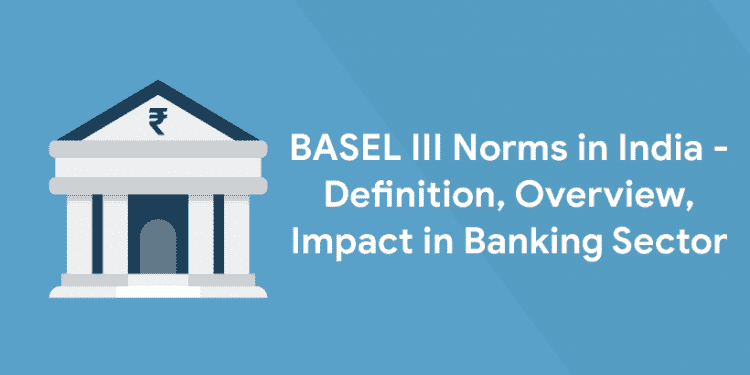Table of Contents
The Covid 19 pandemic has infused a considerable revamp in striking the bell of every sector. The banking sector is also at its doorstep to welcome the essential change in response to the pandemic. According to the news of IANS it is officially announced that the Basel III norms and regulations in India stands deferred till January 2023. The schedule of implementing Basel III is followed by a series of postponements in implementation date and in response of Covid 19 it is again postponed. Through this article we discuss what does this highly anticipated basel III norm mean? What is its significance and what all are its impact on the Indian banking sector?
What is Basel III?
Before we look into Basel III we need to understand some World History. After the 1st world war, a plan named ‘The Young Plan’ was adopted in 1930 for settling Germany’s World war 1 reparations. In this context for implementing this aim a financial institution called the Bank for International Settlement (BIS) has been created. BIS couldn’t enforce its aim and objectives due to the great depression in 1930. After the great depression BIS has incarnated to stabilise global financial stability. Now the BIS is owned by 62 Central Banks, representing countries from around the world that together account for about 95% of world GDP. Its head office is in Basel, Switzerland and it has two representative offices: in Hong Kong SAR and in Mexico City.
One of the major processes of the BIS is the Basel process. The Basel Process refers to the way in which the BIS promotes international cooperation among monetary authorities and financial supervisory officials. The BIS hosts 9 international organizations which comprise 6 committees and 3 associations engaged in standard setting and the pursuit of financial stability through the Basel process. Basel III is an internationally agreed set of measures developed by one of the committees in the BIS, Basel Committee on Banking Supervision (BCBS) in response to the financial crisis of 2007-09. The measures aim to strengthen the regulation, supervision and risk management of banks.
Basel III – A Quick Overview
1: What does the acronym "ATM" stand for in banking?
| Capital | Liquidity | ||
| Pillar 1 | Pillar 2 | Pillar 3 | |
|
Capital
Risk Coverage
Leverage
|
Risk management and supervision
|
Market discipline
|
Global liquidity standards and supervisory monitoring
|
The features of Basel-III such as higher risk coverage, thrust on loss-absorbing capital in periods of stress, improving liquidity standards, creation of capital buffers in good times and prevention of excess build-up of debt during boom times would help create a resilient banking system. I know this table seems to be containing more and more sophisticated information that a banking expert or an economic analyst can understand and squeeze the consequences out of it.
Download Entri for Basel III implementation latest updates
Enroll in Kerala's Top-rated Bank Coaching Program!
Are you ready to take your banking career aspirations to new heights? Join Entri App's Bank Exam Coaching program to kickstart your preparations!
Join Now!How Indian Banking Sector be Affected?
This is the only area where a layman and an economist in India is concerned about. We have to analyse the provisions of Basel III in relevance to Indian scenario. The RBI which is the Central Bank and the regulatory authority over all the banks in India is at doorsteps to implement the recommendation of Basel III into the Indian Banking sector.
The Macro Economic Effect:
- The economist’s analyses that increasing the equity capital requirement increases the average cost of capital to the borrowers as higher lending rates. Thus, the equilibrium lending rates are likely to be marginally higher and as a consequence, credit growth could be a little lower than in the last few years.
- bringing the global common equity capital ratio to a level that would meet the agreed minimum requirement and the capital conservation buffer would result in a maximum decline in GDP
The Lock Down Effect on the Basel III:
- The quarterly assessment of the GDP growth before the lockdown was lower than everyone expected. The post lockdown GDP Growth will be terribly down in the absence of production throughout the country. If the Basel III implementation decelerate the GDP growth even in a small percentage the future growth of India will be in trouble
- The pre lockdown period was experiencing a little inflation that is good for the growth of the economy. And the lockdown period experienced the higher rate of deflation due to the low consumption of goods among people. The immediate post lock down period is experiencing inflation due to the newly restarted production imparts a supply demand mismatch. The economists are expecting a terminal deflation after the post lockdown period. In this frequent changing of inflation and deflation at its peak, Basel III reducing the credit growth would affect the economy negatively.
The Fiscal Policy Towards Basel III:
The central government in 2015 introduced a plan called ‘Indradhanush’ , a seven-point plan to revamp the Public Sector Bank in the economy. In the reforms note it was stated that the PSBs are adequately capitalized and meet all the Basel III and RBI norms. However, the Government of India wants to adequately capitalize all the banks to keep a safe buffer over and above the minimum norms of Basel III. So, the central government is welcoming Basel III through their fiscal policy. The changes on the PSB which is holding the 72% of market among the commercial banking market in India will lead to focus strictly on the strengthening part of the bank but consequently they may compromise the sole responsibility of controlling the inflationary and deflationary trends of the economy.
Download Entri for Basel III implementation latest updates
Conclusion
The Basel III norms and regulations put forward by the BCBS of BIS are something great in strengthening the foundation of the bank in critical situations. But the post lockdown time infuses great and worst changes in the economy and in the mind of the people. It is really doubtful that is it the right time to come up with the revolutionary norms and regulation. The feasibility of the norms and regulation will purely depend upon the factor that how the economy responds to the post lockdown











